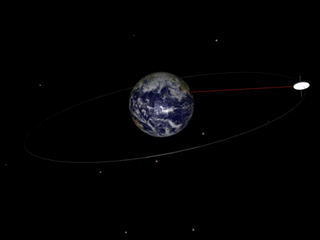|
Military Satellites
A military satellite is an artificial satellite used for a military purpose. The most common missions are intelligence gathering, navigation and military communications. The first military satellites were photographic reconnaissance missions. Some attempts were made to develop satellite based weapons but this work was halted in 1967 following the ratification of international treaties banning the deployment of weapons of mass destruction in orbit. As of 2013, there are 950 satellites of all types in Earth orbit. It is not possible to identify the exact number of these that are military satellites partly due to secrecy and partly due to dual purpose missions such as GPS satellites that serve both civilian and military purposes. As of December 2018 there are 320 known military or dual-use satellites in the sky, half of which are owned by the US, followed by Russia, China and India. [...More Info...] [...Related Items...] OR: [Wikipedia] [Google] [Baidu] |
SAR-Lupe
SAR-Lupe is Germany's first reconnaissance satellite system and is used for military purposes. SAR is an abbreviation for synthetic-aperture radar, and "Lupe" is German for magnifying glass. The SAR-Lupe program consists of five identical (770 kg) satellites, developed by the German aeronautics company OHB-System, which are controlled by a ground stationSAR-Lupe ground station: Zentrum für Nachrichtenwesen der Bundeswehr (ZNBw), Max-Planck-Str. 17, 53501 Gelsdorf . responsible for controlling the system and analysing the retrieved data. A large data archive of images will be kept in a former Cold War bunker belonging to the (Strategic Reconnaissance Command) of the Bundeswehr. The total price of the satellites was over 250 million Euro. Specifications SAR-Lupe's "high-resolution" images can be acquired day or night through all weather conditions. The satellites are able to provide up-to-date imagery from almost all regions of the world. The first satellite was lau ... [...More Info...] [...Related Items...] OR: [Wikipedia] [Google] [Baidu] |
Almaz
The Almaz () program was a highly secret Soviet Union, Soviet military space station program, begun in the early 1960s. Three crewed military reconnaissance stations were launched between 1973 and 1976: Salyut 2, Salyut 3 and Salyut 5. To cover the military nature of the program, the three launched Almaz stations were designated as civilian Salyut programme, Salyut space stations. Salyut 2 failed shortly after achieving orbit, but Salyut 3 and Salyut 5 both conducted successful crewed testing. Following Salyut 5, the Ministry of Defense (Soviet Union), Soviet Ministry of Defense judged in 1978 that the time and resources consumed by station maintenance outweighed the benefits relative to automatic reconnaissance satellites. Still, it had some achievements along with the Salyut program, the heritage of the twin program continues, with the International Space Station module Zarya (ISS module), Zarya being one example. The space stations' cores were known internally as OPS (, M ... [...More Info...] [...Related Items...] OR: [Wikipedia] [Google] [Baidu] |
United States Navy
The United States Navy (USN) is the naval warfare, maritime military branch, service branch of the United States Department of Defense. It is the world's most powerful navy with the largest Displacement (ship), displacement, at 4.5 million tons in 2021. It has the world's largest aircraft carrier fleet, with List of aircraft carriers in service, eleven in service, one undergoing trials, two new carriers under construction, and six other carriers planned as of 2024. With 336,978 personnel on active duty and 101,583 in the Ready Reserve, the U.S. Navy is the third largest of the United States military service branches in terms of personnel. It has 299 deployable combat vessels and about 4,012 operational aircraft as of 18 July 2023. The U.S. Navy is one of six United States Armed Forces, armed forces of the United States and one of eight uniformed services of the United States. The United States Navy traces its origins to the Continental Navy, which was established during ... [...More Info...] [...Related Items...] OR: [Wikipedia] [Google] [Baidu] |
Transit (satellite)
The Transit system, also known as NAVSAT or NNSS (for ''Navy Navigation Satellite System''), was the first satellite navigation system to be used operationally. The radio navigation system was primarily used by the U.S. Navy to provide accurate location information to its UGM-27 Polaris, Polaris ballistic missile submarines, and it was also used as a navigation system by the Navy's surface ships, as well as for hydrographic survey and geodetic surveying. Transit provided continuous navigation satellite service from 1964, initially for Polaris submarines and later for civilian use as well. In the Project DAMP Program, the missile tracking ship USAS American Mariner also used data from the satellite for precise ship's location information prior to positioning its tracking radars. History The Transit satellite system, sponsored by the Navy and developed jointly by DARPA and the Johns Hopkins Applied Physics Laboratory, under the leadership of Dr. Richard Kershner at Johns Hop ... [...More Info...] [...Related Items...] OR: [Wikipedia] [Google] [Baidu] |
Satellite Navigation
A satellite navigation or satnav system is a system that uses satellites to provide autonomous geopositioning. A satellite navigation system with global coverage is termed global navigation satellite system (GNSS). , four global systems are operational: the United States's Global Positioning System (GPS), Russia's Global Navigation Satellite System (GLONASS), China's BeiDou Navigation Satellite System (BDS), and the European Union, European Union's Galileo (satellite navigation), Galileo. Two regional systems are operational: India's Indian Regional Navigation Satellite System, NavIC and Japan's Quasi-Zenith Satellite System, QZSS. ''Satellite-based augmentation systems'' (SBAS), designed to enhance the accuracy of GNSS, include Japan's Quasi-Zenith Satellite System (QZSS), India's GAGAN and the European EGNOS, all of them based on GPS. Previous iterations of the BeiDou navigation system and the present Indian Regional Navigation Satellite System (IRNSS), operationally known as ... [...More Info...] [...Related Items...] OR: [Wikipedia] [Google] [Baidu] |
Geosynchronous Orbit
A geosynchronous orbit (sometimes abbreviated GSO) is an Earth-centered orbit with an orbital period that matches Earth's rotation on its axis, 23 hours, 56 minutes, and 4 seconds (one sidereal day). The synchronization of rotation and orbital period means that, for an observer on Earth's surface, an object in geosynchronous orbit returns to exactly the same position in the sky after a period of one sidereal day. Over the course of a day, the object's position in the sky may remain still or trace out a path, typically in a figure-8 form, whose precise characteristics depend on the orbit's inclination and eccentricity. A circular geosynchronous orbit has a constant altitude of . A special case of geosynchronous orbit is the geostationary orbit (often abbreviated ''GEO''), which is a circular geosynchronous orbit in Earth's equatorial plane with both inclination and eccentricity equal to 0. A satellite in a geostationary orbit remains in the same position in the sky to observers ... [...More Info...] [...Related Items...] OR: [Wikipedia] [Google] [Baidu] |
Intelsat 901
Intelsat 901 (IS-901) is the first of nine new Intelsat satellites launched in June 2001 at 18° West, providing Ku-band spot beam coverage for Europe and C-band coverage for the Atlantic Ocean region. It is capable of selectable split uplink for Satellite news gathering (SNG), tailored for increased communications demands such as DTH and Internet. Satellite Intelsat 901 was launched by an Ariane 4 from the Centre Spatial Guyanais in French Guiana on 9 June 2001 at 06:45 UTC. * Increased power – Intelsat 901 is designed to provide up to 5 dB for downlink EIRP, and up to 1.8 dB for G/T over the Intelsat 7 series satellites. * Increased Capacity – with over 72 C-band, 36 MHz equivalent unit transponders, Intelsat 901 provides a significant increase in capacity over the previous satellite at 18° West. * Improved Coverage – Intelsat 901 provides significantly expanded zone coverage. The Ku-band spot beams also include more areas within each zone. Encounter with Ru ... [...More Info...] [...Related Items...] OR: [Wikipedia] [Google] [Baidu] |
Intelsat 7
Intelsat 7, formerly PAS-7, was a communications satellite operated by Intelsat which spent most of its operational life serving the Europe, Africa, Middle East, Asia market from a longitude of 18° West. Satellite description PAS-7 was constructed by Space Systems/Loral, based on the LS-1300 satellite bus. It had a mass at launch of . Designed for an operational life of 15 years, the spacecraft was equipped with 14 C-band at 50 watts and 30 Ku-band at 100 watts transponders. Launch Arianespace launched PAS-7, using an Ariane 4 launch vehicle, flight number V98, in the Ariane 44LP H10-3 configuration. The launch took place from ELA-2 at the Centre Spatial Guyanais, at Kourou in French Guiana, on 16 September 1998, at 06:31 UTC. Decommissioning PAS-7 experienced a sudden reduction of approximately 25% of its power capacity because a technical difficulty with one of the satellite's solar panels. The incident took place on 6 September 2001 when the satellite came out of s ... [...More Info...] [...Related Items...] OR: [Wikipedia] [Google] [Baidu] |
Olymp-K
Olymp-K ( meaning ''Olympus'') is a Russian geostationary satellite built for the Russian Ministry of Defence and Federal Security Service (FSB). The satellite is also referred to as "Luch". It is believed to be a signals intelligence satellite. Launch Olymp-K was launched on 28 September 2014. The Proton-M rocket with a Briz-M upper stage launched from Baikonur Cosmodrome launchpad 81/24 in Kazakhstan at 20:23 UTC. After four burns of the Briz-M upper stage it was placed into geosynchronous transfer orbit. In a press release on 28 September 2014, Roscosmos referred to the satellite as " Luch". Manoeuvres Following its launch, the Olymp-K satellite made several manoeuvres before settling at 18.1° West longitude around 4 April 2015. The satellite was then positioned in an orbit directly between Intelsat 901, which was located at 18° West, and Intelsat 7, located at 18.2° West. It remained in geosynchronous orbit between the satellites for five months. At times, Olymp-K perfo ... [...More Info...] [...Related Items...] OR: [Wikipedia] [Google] [Baidu] |
Government Of Russia
The Russian Government () or fully titled the Government of the Russian Federation () is the highest federal executive governmental body of the Russian Federation. It is accountable to the president of the Russian Federation and controlled by the State Duma. The status and procedure of its activities are determined by chapter 6 of the Constitution of the Russian Federation and the provisions of the federal constitutional law "On the Government of the Russian Federation". The Government's terms of reference include the development and enforcement of the federal budget and the implementation of socially oriented government policies in various cultural areas of Russian society. Although the Government of the Russian Federation does not adopt laws, its responsibilities include issuing federal by-laws (resolutions) based on federal laws passed by the Federal Assembly. According to the 1991 amendment to the 1978 constitution, the president of Russia was the head of the executi ... [...More Info...] [...Related Items...] OR: [Wikipedia] [Google] [Baidu] |
Intelsat
Intelsat S.A. (formerly Intel-Sat, Intelsat) is a Luxembourgish-American multinational satellite services provider with corporate headquarters in Luxembourg and administrative headquarters in Tysons, Virginia, United States. Originally formed as International Telecommunications Satellite Organization (''ITSO'', or Intelsat), from 1964 to 2001, it was an intergovernmental consortium owning and managing a constellation of communications satellites providing international telecommunications and broadcast services. In March 2023, rival satellite operator SES confirmed that it was in talks about a merger with Intelsat but in June 2023, it was announced that these discussions had ended. On 30 April 2024, SES announced that an agreement had been reached to acquire Intelsat for US$3.1 billion, with the transaction expected to close in the second half of 2025. As of June 2022, Intelsat operated a fleet of 52 communications satellites which was then one of the world's largest fleet ... [...More Info...] [...Related Items...] OR: [Wikipedia] [Google] [Baidu] |



